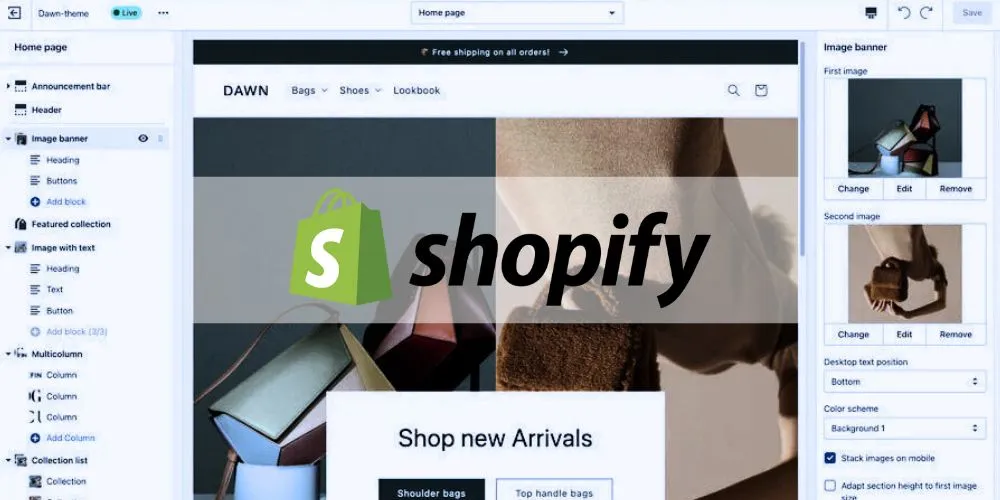E-commerce has significantly changed the retail landscape, enabling businesses to connect with customers and boost revenue. A key player in this evolution is Shopify, a cloud-based e-commerce platform that helps small and medium-sized enterprises effortlessly build and manage their online storefronts. Founded in 2006, the company has experienced remarkable growth, establishing itself as a significant force in the e-commerce industry. This case study explores Shopify’s development, its effects on small businesses, the evolving e-commerce environment, and the future of online retail.
Background of E-Commerce
The e-commerce industry has revolutionized the way consumers shop and businesses operate.
The Evolution of Retail
The retail industry has changed significantly over the past few decades, evolving from traditional brick-and-mortar stores to digital marketplaces.
- The Internet Boom: The advancement of Internet technologies in the late 20th century laid the foundation for online shopping. Websites began selling products directly to consumers, offering convenience and a more comprehensive selection than physical stores.
- The Rise of Marketplaces: Platforms like Amazon and eBay emerged as significant players, providing consumers with vast product choices and competitive pricing. These marketplaces established new standards for customer service, shipping, and payment options.
The Need for E-Commerce Solutions
As e-commerce gained traction, small and medium-sized businesses sought ways to enter the digital marketplace.
- Barriers to Entry: While larger companies could invest in custom e-commerce solutions, smaller businesses faced significant barriers, including high development costs and technical expertise requirements.
- Demand for User-Friendly Platforms: The growing demand for e-commerce solutions highlighted the need for user-friendly platforms that allowed businesses to establish an online presence without extensive technical knowledge.
The Birth of Shopify
Shopify was founded in 2006 by Tobias Lütke, Daniel Weinand, and Scott Lake. It was intended to solve Lütke’s frustration with existing e-commerce platforms.
Founding Vision
The founders recognized a gap in the market for accessible e-commerce solutions tailored to small businesses.
- Empowering Entrepreneurs: The platform’s vision was to enable entrepreneurs and small business owners by providing tools to create and manage their online stores easily.
- Simplicity and Accessibility: Shopify aimed to simplify the e-commerce process and make it accessible to anyone, regardless of technical skills or resources.
Early Growth and Development
Shopify launched its platform in June 2006. It offered a subscription-based service, allowing businesses to set up online stores quickly.
- Initial Features: The platform included customizable templates, secure payment processing, and inventory management tools, enabling businesses to manage their online presence efficiently.
- Rapid Adoption: Within a few years, Shopify gained traction, attracting thousands of companies seeking a straightforward solution to establish an online store.
The E-Commerce Boom
The e-commerce sector experienced unprecedented growth, particularly during the COVID-19 pandemic, accelerating the shift toward online shopping.
Pandemic-Driven Growth
The COVID-19 pandemic significantly impacted consumer behavior, leading to a surge in e-commerce.
- Lockdowns and Social Distancing: With physical stores closed or operating at limited capacity, consumers turned to online shopping as their primary means of purchasing goods.
- Increased Demand for E-Commerce Solutions: The sudden influx of businesses seeking to establish online stores led to heightened demand for platforms like Shopify, facilitating the transition to e-commerce.
Shopify’s Response to the Boom
Shopify capitalized on the e-commerce boom by rapidly expanding its offerings and capabilities.
- Enhanced Features: The platform introduced features such as Payments, Shipping, and Capital, providing users with comprehensive solutions to manage their businesses effectively.
- Support for Businesses: The company launched initiatives to support businesses during the pandemic, including resources for setting up online stores, marketing assistance, and financial support through Shopify Capital.
Impact on Small Businesses
Shopify has played a pivotal role in enabling small businesses to thrive in the e-commerce landscape.
Empowering Entrepreneurs
By providing an accessible platform, the company has empowered countless entrepreneurs to launch and grow their businesses.
- Low Barrier to Entry: Shopify’s subscription-based model and user-friendly interface have lowered the barrier to entry for aspiring business owners. Entrepreneurs can create and manage online stores with minimal upfront investment.
- Diverse Business Models: The platform supports various business models, including dropshipping, print-on-demand, and digital product sales, allowing entrepreneurs to choose the model that best suits their goals.
Success Stories
Numerous small businesses have achieved remarkable success using Shopify’s platform.
- Case Study: Gymshark: Founded in 2012, Gymshark is a fitness apparel brand that began as a small operation selling products online. Using the platform, Gymshark scaled rapidly, becoming a multi-million dollar business with a solid online presence and a loyal customer base.
- Case Study: Allbirds: Allbirds, a sustainable footwear brand, leveraged Shopify to create an engaging online shopping experience. The brand’s emphasis on eco-friendly products resonated with consumers, contributing to its rapid growth and success.
The E-Commerce Ecosystem
Shopify has positioned itself as a global e-commerce leader, fostering partnerships and integrations that enhance its offerings.
App Marketplace
Shopify’s App Store features thousands of third-party applications that extend the platform’s functionality.
- Integration with Popular Tools: Businesses can streamline operations by integrating various tools and services, such as marketing automation, customer relationship management (CRM), and accounting software.
- Customization Options: The availability of apps allows users to customize their stores to meet their unique needs, enhancing the overall user experience.
Partnerships and Collaborations
Shopify has established strategic partnerships to enhance its offerings and reach.
- Payment Processors: The platform has collaborated with various payment processors, including PayPal, Stripe, and Apple Pay, ensuring seamless payment experiences for customers.
- Logistics and Shipping Solutions: Partnerships with shipping providers like USPS and UPS have enabled Shopify merchants to offer competitive shipping options, enhancing customer satisfaction.
Challenges and Competition
While Shopify has experienced significant growth, it faces challenges and competition in the evolving e-commerce landscape.
Increasing Competition
The e-commerce market is highly competitive, with various platforms vying for market share.
- Direct Competitors: The company competes with other e-commerce platforms like WooCommerce, BigCommerce, and Wix. Each platform offers unique features and pricing models, making it essential for Shopify to differentiate itself.
- Market Saturation: As online stores increase, competition for consumer attention and market share intensifies. Businesses must find innovative ways to stand out in a crowded marketplace.
Maintaining User Satisfaction
As Shopify grows, it must balance the demands of its expanding user base with maintaining high-quality support and service.
- Customer Support: Providing adequate customer support is critical for user satisfaction. The company has invested in expanding its support resources, including live chat, tutorials, and community forums.
- Platform Reliability: Ensuring platform reliability and performance is vital for businesses relying on Shopify for their e-commerce operations. Any downtime or technical issues can impact sales and customer trust.
The Future of Shopify and E-Commerce
The future of Shopify and the broader e-commerce landscape is filled with many opportunities and challenges as consumer behavior evolves.
Embracing Emerging Technologies
Shopify is well-positioned to leverage emerging technologies to enhance the e-commerce experience.
- Artificial Intelligence (AI): Integrating AI-powered tools for personalized marketing, inventory management, and customer service can give merchants valuable insights and improve efficiency.
- Augmented Reality (AR): AR technology offers exciting possibilities for enhancing the online shopping experience. Shopify has begun exploring AR capabilities, enabling customers to visualize products in their environment.
Expanding Global Reach
As e-commerce continues to grow globally, Shopify aims to expand its reach in international markets.
- Localized Solutions: Adapting the platform to meet the unique needs of different regions, including language support and payment options, will be crucial for Shopify’s global expansion.
- Support for International Merchants: The company has introduced features for international merchants, such as multi-currency support and cross-border shipping solutions to facilitate global sales.
Conclusion
Shopify’s journey from a small startup to a leading e-commerce platform demonstrates its commitment to empowering small businesses and revolutionizing the retail landscape. By providing accessible tools and resources, the platform has enabled countless entrepreneurs to establish and grow their online stores, contributing to the explosive growth of e-commerce.
As the e-commerce landscape continues to evolve, Shopify remains at the forefront, embracing emerging technologies and expanding its global reach. While challenges and competition persist, the company’s focus on innovation and user satisfaction positions it well for continued success in online retail’s rapidly evolving world. Shopify’s impact on small businesses and the broader e-commerce ecosystem will shape the future of retail, driving further growth and transformation in the years to come.












